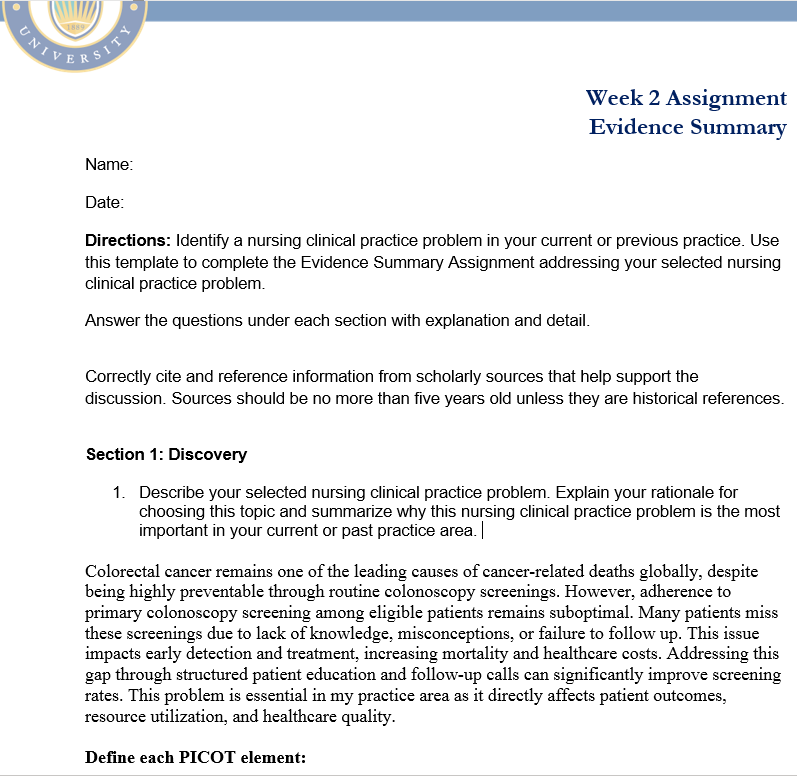CLASS:
NR451 – RN Capstone Course
Preparing the Assignment
Follow these guidelines when completing each component of the assignment. Contact your course faculty if you have questions.
Directions
Complete the Evidence Summary template by following the steps below.
- Download the Week 2 Evidence Summary template. Use of this template is required. A 10% deduction will be applied if the template is not used. See the rubric. Save the template and include your name in the file name.
- Identify a nursing clinical practice problem in your current or previous nursing practice. Complete the Evidence Summary template addressing your selected nursing clinical practice problem.
- Correctly cite and reference information from scholarly sources that help support the discussion. Sources should be no more than five years old unless they are historical references.
- Follow grammar, spelling, word usage, and punctuation rules consistent with formal, scientific writing.
- Abide by Chamberlain University’s academic integrity policy.
Include the following sections (detailed criteria listed below and in the grading rubric). Answer the questions under each section with explanation and detail.
Section 1: Discovery
- Describe your selected nursing clinical practice problem. Explain your rationale for choosing this topic and summarize why this nursing clinical practice problem is the most important in your current or past practice area.
- Define each PICOT element.
- Write out your PICOT question using the standard format.
- Describe how you selected the population, intervention, outcome, and time frame.
Section 2: Evidence Summary Systematic Review
- Using only the Chamberlain University Library, locate one systematic review relevant to your chosen nursing clinical practice problem that supports the intervention and has been published within the past five (5) years.
- Provide the complete APA reference to the evidence, including the permalink. State which database you found the evidence in.
- Explain why the evidence is relevant to your selected nursing clinical practice problem and population.
- Explain how the evidence is relevant to your selected intervention. What data from the article helps support the implementation of this intervention into practice?
Section 3: Evidence Summary Peer-Reviewed Quantitative Research Study
- Using only the Chamberlain University Library, locate one peer-reviewed quantitative research study relevant to your chosen nursing clinical practice problem that supports the intervention and has been published within the past five (5) years.
- Provide the complete APA reference to the evidence, including the permalink. State which database you found the evidence in.
- Explain why the evidence is relevant to your selected nursing practice problem and population.
- Explain how the evidence is relevant to your selected intervention. What data from the article helps support the implementation of this intervention into practice?
Section 4: Evidence-Based Intervention
- Describe the selected evidence-based nursing intervention in detail. How could this intervention be implemented in your practice area?
- Explain how the intervention supports the outcome and addresses your identified nursing clinical practice problem.
- What interprofessional team members would it be important to collaborate with? Explain.
SOLUTION
Section 1: Discovery
Describe your selected nursing clinical practice problem. Explain your rationale for choosing this topic and summarize why this nursing clinical practice problem is the most important in your current or past practice area.
Colorectal cancer (CRC) is a leading cause of cancer-related mortality worldwide. Early detection through screening colonoscopies significantly reduces CRC incidence and mortality. However, adherence to recommended screening guidelines remains suboptimal, particularly among eligible adults. Factors contributing to low adherence include lack of awareness, misconceptions about the procedure, and inadequate follow-up. Addressing this issue is crucial in my practice area, as increasing screening rates can lead to early detection, improved patient outcomes, and reduced………………………………….purchase at $10

Reviews
There are no reviews yet.